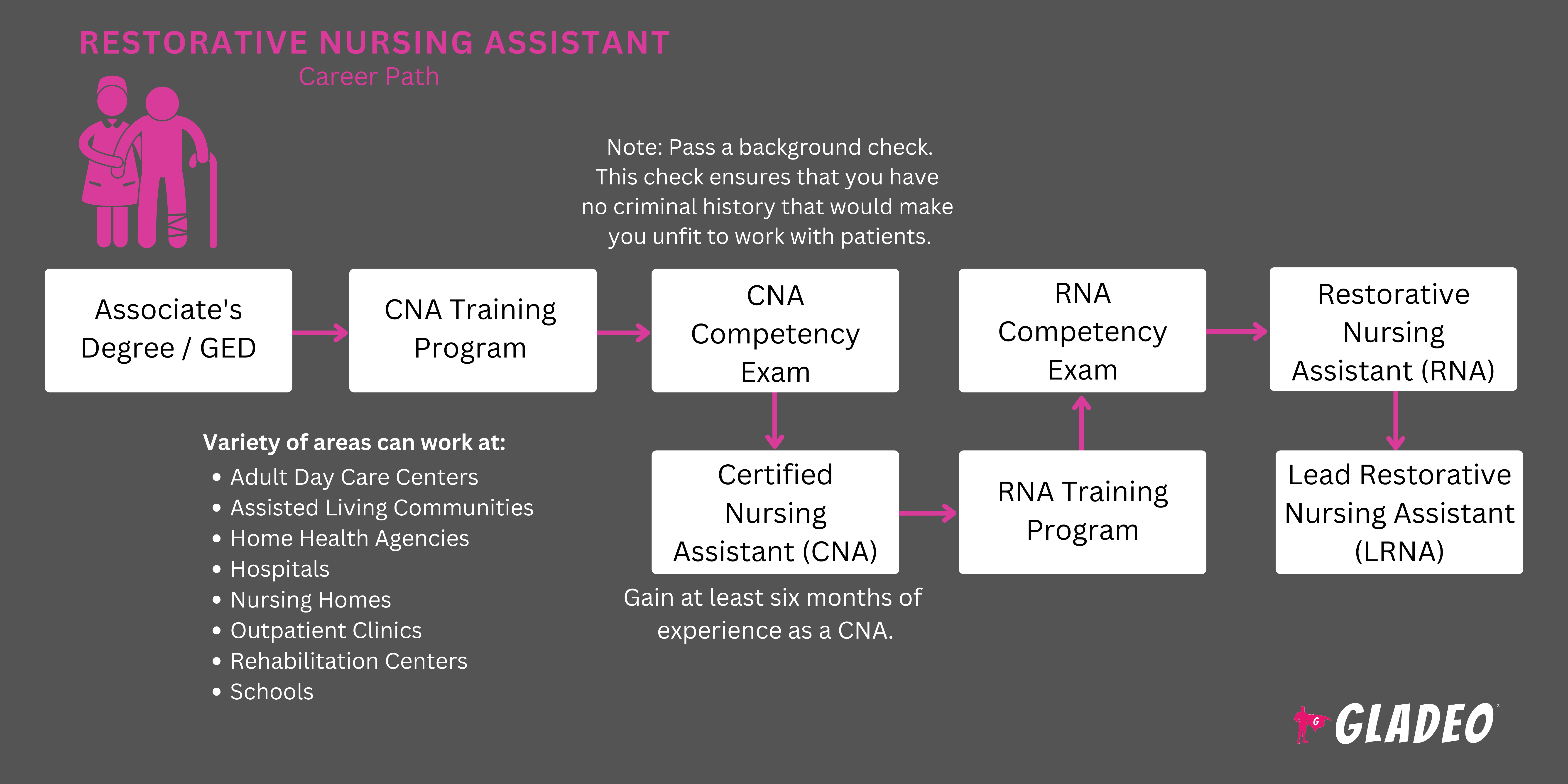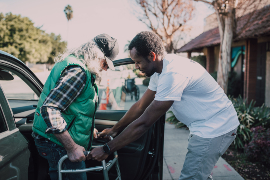Mga spotlight
Certified Medication Aide (CMA), Certified Nurse Aide (CNA), Certified Nurses Aide (CNA), Certified Nursing Assistant (CNA), Licensed Nursing Assistant (LNA), Nurses' Aide, Nursing Aide, Nursing Assistant, Patient Care Assistant (PCA). ), State Tested Nursing Assistant (STNA)
After a serious injury or long illness, patients often lose strength, coordination, and cognitive function and need help getting back to their normal lives. That’s where Restorative Nursing Assistants (RNAs) come into play!
RNAs specialize in restorative therapeutic care, assisting recovering patients to regain physical and cognitive capabilities through mobility exercises and activities. They work in a range of long-term settings, such as nursing homes and rehabilitation centers, performing tasks under the guidance of licensed nurses and therapists.
RNAs follow their patient’s rehabilitation plans, ensure patient safety and comfort, monitor and document progress, and communicate with the rest of the healthcare team so that plans can be adjusted, as needed. Their important work contributes greatly to the well-being of patients who are seeking to regain as much independence as possible.
- Gumagawa ng epekto sa kalusugan, haba ng buhay, at pang-araw-araw na kalidad ng buhay ng mga pasyente
- Helping patients regain independence to perform daily tasks
- Lumalaki ang pangangailangan sa larangan ng pangangalagang pangkalusugan
- Maraming mga pagkakataon para sa personal at propesyonal na paglago
Working Schedule
Restorative Nursing Assistants may work part-time or full-time. Shifts may include nights, weekends, or holidays.
Typical Duties
“An RNA is an advanced CNA [Certified Nursing Assistant],” writes Indeed. Thus there can be some overlap of duties between the two professions, depending on the setting and situation.
- Assist with therapeutic range-of-motion exercises, ambulation training, and other activities prescribed by physical or occupational therapists
- Support patients with personal hygiene (i.e., bathing, grooming, using the toilet) and dressing as they work toward independence and rehabilitation goals
- Serve meals and help patients eat, paying attention to the dietary needs of their care plan
- Help patients transfer between beds and wheelchairs. Assist with walking and repositioning for comfort and therapeutic benefit
- Monitor, record, and track patients’ progress in activities and exercises, noting changes in abilities or conditions
- Report any patient condition changes to the supervising nurse for appropriate action
- Provide companionship, support, and encouragement to patients working on restorative activities
- Document responses to restorative treatments, exercise progress, and health concerns
- Ensure effective communication between patients and healthcare professionals, including physical and occupational therapists, to ensure a cohesive approach to care
- Advocate for patient needs and preferences
- Suggest resources to learn more about nutrition and safety so patients can live healthier lives after being discharged
- If trained and authorized, RNAs may also:
- Tumulong sa mga hindi invasive na pamamaraang medikal, tulad ng pagbibihis ng mga sugat
- Remind patients to take prescribed medications
- Assist with the collection of urine or stool samples
- Ihatid ang mga pasyente sa mga appointment
Mga Karagdagang Pananagutan
- Assist with training new RNAs, sharing knowledge and techniques specific to restorative care
- Help set up and maintain equipment used for restorative exercises and activities
- Participate in interdisciplinary team meetings to discuss and plan patient care
- Tumulong sa paglalaba, mga gawain, at pag-iiskedyul ng appointment
- Tulong sa pagpapalabas ng mga pasyente
Soft Skills
- Ugaling pag-aalaga
- Pagkahabag
- Katatagan
- pagiging maaasahan
- Mabusisi pagdating sa detalye
- Emosyonal na katatagan
- Empatiya
- Integridad
- Mga kasanayan sa interpersonal
- mapagmasid
- pasensya
- Pisikal na tibay
- Pagbubuo ng relasyon
- pagiging maaasahan
- May kamalayan sa kaligtasan
- Mukhang makatarungan
- Malakas na kasanayan sa komunikasyon
- Pagtutulungan at pagtutulungan
Teknikal na kasanayan
- Knowledge of rehabilitation and restorative care techniques (i.e., exercises, mobility assistance, cognitive activities, etc.)
- Understanding how to encourage independence during rehabilitation
- Familiarity with hygiene, sterilization practices, and infection control in rehabilitation or long-term care settings
- Proficiency in using/maintaining equipment for restorative care
- Expertise in documenting and maintaining patient records
- Knowledge of common medical conditions in long-term care/rehabilitation settings
- Understanding the roles of rehabilitation professionals such as physical and occupational therapists
- Acute care hospitals
- Mga pasilidad ng Alzheimer
- Mga assisted living center
- Mga day care center na nakabatay sa komunidad para sa mga nasa hustong gulang
- Patuloy na pangangalaga sa mga komunidad ng pagreretiro
- Mga ahensya ng kalusugan ng gobyerno at komunidad
- Mga pasilidad sa pangangalaga sa hospice
- Mga yunit ng rehabilitasyon ng mga ospital
- Mga pasilidad ng pangangalaga sa nars (skilled nursing facility)
- Mga nursing home at mga pasilidad ng pangmatagalang pangangalaga
- Mga sentro ng outpatient
- Mga sentro ng rehabilitasyon
- Mga pasilidad ng espesyal na pangangalaga
- Mga departamento ng therapy
Restorative Nursing Assistants play a crucial role in the rehabilitation and ongoing care of patients facing challenges due to age, disability, or chronic conditions. RNAs help implement and monitor tailored restorative care plans, sometimes for multiple patients each day. This requires excellent organizational and prioritization skills, along with diligent record-keeping.
Assisting patients with mobility and therapeutic exercises can be physically demanding. Meanwhile, daily interactions with recovering or ill patients can be stressful and emotionally taxing at times. Thus, resilience, patience, and empathy are always necessary.
RNAs frequently work night, weekend, and holiday shifts, requiring adaptability and a flexible schedule. They must also find time to decompress and manage appropriate self-care to maintain their own mental and physical well-being and avoid burnout.
The healthcare sector, especially in long-term and rehabilitative care, is facing a shortage of trained professionals—including RNAs. This is partially due to America’s aging population living longer and thus needing more years of specialized care.
The shortage is exacerbated by millions of nurses retiring or preparing to retire, creating a shortage of teaching staff to train their own replacements. As a result, RNA training program applicants should be persistent and keep applying to programs if they happen to get turned down at first.
Online educational programs are doing their part to make learning more flexible and reduce barriers to accessible training. In the meantime, the rising workload is stretching the current nursing workforce thin, raising the importance of self-care to prevent fatigue, stress, or burnout.
RNAs may have always been interested in physical activities and wanted to teach others about the long-term health benefits of exercise. In their younger years, they could have assisted loved ones who needed help due to age, injury, or illness. RNAs usually have a strong desire to make a difference in the lives of others, and the ability to motivate patients to stick with their care plans and overcome obstacles.
Edukasyon ang Kailangan
- To become an RNA, applicants generally need a high school diploma or equivalent, plus need to be a Certified Nursing Assistant (CNA)
- Some employers may hire applicants who are close to obtaining their CNA certification
- In addition to being a nursing assistant, RNA hopefuls must usually have relevant work experience (for example, six months of working as a CNA) and be in good standing with their respective state
- RNA training programs may require a letter of recommendation from the director of nursing where the CNA applicant last worked
- Qualified applicants can complete a state-approved RNA training program through a community college, vocational/technical school, nurse training school, or select four-year colleges. Some high schools offer CNA training courses to get a jump start on an RNA career
- Depending on the program, certain courses could be online, in-person, or via a hybrid method
- Note, the number of training hours may vary by state, institution, and other factors A typical program may include:
- 30 hours of classroom and laboratory instruction, with written tests
- 30 hours of supervised clinical practice, depending on the student's exhibited abilities
- A practical exam to evaluate skills related to speech therapy, occupational therapy, physical therapy, and other skills
- Courses cover “various essential topics related to restorative care, including rehabilitation and its function, effects of aging, basic anatomy, diseases impacting mobility, promoting independence, resident transfers, ambulation, types of exercise, available restorative aide equipment, communication, and medical terminology”
- Note, in some states, CNA certification involves passing an exam. In addition, some healthcare facilities have their own requirements
- RNA hopefuls must meet the same immunization requirements as a CNA (based on the demands of the state or employer), such as seasonal flu vaccination, Tdap, MMR, hepatitis B, varicella, and meningococcal
- They may have to pass criminal background and drug screening. Also, employers must find no registry information concerning abuse, neglect, or misappropriation of property
- RNAs may complete optional credentials, such as:
- Certified Wound Care Associate ng American Board of Wound Management
- American Council on Exercise's Functional Training Specialty Certification
- Certification ng Technician sa Pag-aalaga ng Pasyente ng American Medical Certification Association
- Technician sa Pangangalaga ng Pasyente ng American Phlebotomy Association
- American Red Cross Basic Life Support Certification
- Certified Medication Assistant (CMA)
- Hospice at Palliative Nurses Association's Certified Hospice at Palliative Nursing Assistant
- National Association for Practical Nurse Education at Sertipikasyon ng Intravenous Therapy ng Serbisyo
- National Center for Competency Testing's Nationally Certified Patient Care Technician
- National Certification Board para sa Certified Alzheimer Caregiver ng Alzheimer Care
- National Council of State Boards of Nursing's National Nurse Aide Assessment Program
- Ang Certified Patient Care Technician/Assistant ng National Healthcareer Association
- Rehabilitation Engineering at Assistive Technology Society of North America's Seating and Mobility Specialist
Restorative Nursing Assistants don’t have to attend training at a university. Training programs are available at community colleges, vocational/technical schools, nurse training schools, and select four-year colleges. In addition, CNA programs are offered in some high school programs.
- Review the exact CNA and RNA training and certification/licensure requirements for the state you plan to work for.
- Isaalang-alang ang mga gastos sa pagtuturo (mga rate sa loob ng estado/sa labas ng estado), mga diskwento, mga scholarship, at mga opsyon sa paghahatid ng kurso (sa campus, online, o hybrid na programa).
- Look for accredited programs with strong reputations and high pass rates for state certification exams, as applicable.
- Suriin ang mga available na opsyon para sa hands-on na pagsasanay sa mga lokal na setting ng pangangalagang pangkalusugan.
- Isaalang-alang ang tagal ng programa at ang flexibility ng mga iskedyul ng klase, lalo na kung pagbabalanse ng iba pang mga commitment.
- Suriin ang faculty bios at mga parangal. Alamin ang tungkol sa mga rate ng pagtatapos at mga istatistika ng placement ng trabaho. Silipin ang mga nagawa ng alumni network!
- Magboluntaryo sa mga setting ng pangangalagang pangkalusugan upang makakuha ng pagkakalantad at makakuha ng mga praktikal na kasanayan
- Kumuha ng mga klase sa high school na nauugnay sa anatomy, physiology, biology, chemistry, physical education, nutrition, psychology, health sciences, first aid, math, at English
- Earn good grades so you can get accepted into a suitable RNA training program
- Develop a solid workout schedule so you build stamina and strength while managing stress
- Panatilihin ang isang malusog na diyeta at regular na iskedyul ng pagkain, upang panatilihing pare-pareho ang iyong mga antas ng enerhiya
- Makilahok sa mga aktibidad sa paaralan kung saan maaari kang bumuo ng mga kasanayan sa pamamahala ng proyekto, pagtutulungan ng magkakasama, karanasan sa pamumuno, at paglutas ng salungatan
- Think about the format you want to take RNA classes in. Some topics are fine for online study, but others need to be learned in person
- Research any unique state or potential employer requirements for becoming an RNA. Keep in mind that you may have to pass a criminal background check or drug screening
- Request to do an informational interview with a working RNA to learn about their daily duties
- Check out online articles and videos about the Restorative Nursing Assistant career field, the various settings you could work in, and extra certifications you may want to pursue!
- Panatilihin ang isang listahan ng mga contact (na may mga numero ng telepono o email) na maaaring magsilbing mga sanggunian sa trabaho sa hinaharap
- Panatilihin ang isang gumaganang draft ng iyong resume at i-update ito habang nakakakuha ka ng karanasan

- Once certified as a CNA to work in their respective states, and after RNA training has been completed, it’s time to explore job postings via sites like Indeed, Glassdoor, healthcare-specific job search sites, and the websites of applicable employers
- Note, many recruiters have established pipelines with local CNA and RNA training programs, so talk to your school’s program manager or career center about job placement assistance
- Makipag-ugnayan sa mga kapwa propesyonal sa pangangalagang pangkalusugan upang malaman ang tungkol sa mga pagkakataon sa trabaho. Huwag maliitin ang kapangyarihan ng “salita ng bibig” na pagre-recruit!
- Advertise yourself on LinkedIn and always keep your social media professional. Potential employers often screen candidates’ online activities
- Check out Restorative Nursing Assistant resumes for ideas on formatting, phrasing, and keywords to use
- Keywords may include: Restorative care, patient rehabilitation, mobility assistance, range of motion exercises, ADL support (Activities of Daily Living), patient monitoring, care plan implementation, therapy assistance, medical terminology, patient safety, compassionate care, teamwork, documentation, patient education, communication skills, adaptive equipment use, regulatory compliance, patient assessments, interdisciplinary collaboration, infection control
- Suriin ang mga potensyal na tanong sa pakikipanayam na inaasahan. Gumawa ng ilang kunwaring panayam para sanayin ang iyong mga tugon
- Magpakita ng isang nakabubusog at mapag-aruga na saloobin na naghahatid ng iyong kakayahang pisikal at mental na pangasiwaan ang kargada ng trabaho
- Basahin ang tungkol sa mga diskarte na ginagamit ng mga recruiter, upang makakuha ng pananaw ng kanilang mindset sa panahon ng mga panayam
- Magsuot ng propesyonal para sa mga panayam
- Discuss your restorative care career goals with your supervisor. Ask for their guidance and mentorship
- Build a reputation for exceptional patient care and engagement related to restorative practices
- Familiarize yourself thoroughly with employer policies and procedures
- Closely follow restorative care plans and protocols to ensure patient safety and comfort as they recover
- Adhere strictly to sanitation and hygiene protocols
- Maintain effective communication with patients, nurses, and other healthcare team members
- Read journals and take continuing education courses to stay informed about the latest best practices
- Consider pursuing additional qualifications to expand your options and opportunities!
- Study guides and manuals for equipment and software. Become a go-to subject matter expert
- Demonstrate competence, integrity, reliability, initiative, professionalism, and leadership at all times
- Share insights and techniques with fellow RNAs, and set the example to follow
- Engage with professional organizations related to restorative and rehabilitative care
- Attend and participate in events. Be proactive in establishing and building your professional standing within your network!
Mga website
- American Association of Post-Acute Care Nursing
- American Health Care Association
- American Nurses Association
- American Occupational Therapy Association
- American Physical Therapy Association
- Komisyon sa Collegiate Nursing Education
- Geriatric Nursing
- Gerontological Advanced Practice Nurses Association
- International Journal of Nursing Practice
- Journal of Nursing Care Quality
- Journal of Nursing Education
- Journal ng Propesyonal na Nursing
- Journal of Rehabilitation Medicine
- Journal ng American Geriatrics Society
- National Association for Home Care and Hospice
- National Association for Practical Nurse Education and Service
- Pambansang Samahan ng mga Katulong sa Pangangalagang Pangkalusugan
- National Center for Competency Testing
- National Certification Board para sa Alzheimer Care
- National Council of Certified Dementia Practitioners
- National Council of State Boards of Nursing
- National Healthcareer Association
- National Rehabilitation Information Center
- Nurse.com
- Nursing Assistant Guides
- Mga Nursing Assistant Online
- Pamantayan sa Pag-aalaga
- Rehabilitation Nursing Journal
- Society of Certified Senior Advisors
- Ang American Journal of Nursing
- Ang Gerontologist
Mga libro
- Mosby’s Essentials for Nursing Assistants, by Leighann Remmert MS RN, and Sheila A. Sorrentino Ph.D. RN
- Nursing Assistant: Isang Nursing Process Approach , nina Barbara Acello at Barbara Hegner
- Restorative Care: Fundamentals for the Certified Nursing Assistant, by Barbara Acello
- Restorative Care Nursing for Older Adults: A Guide For All Care Settings, by Elizabeth Galik Ph.D. CRNP, Ingrid Pretzer-Aboff Ph.D. RN, et al.
RNAs are critical members of the healthcare profession, but the job can be physically demanding at times. For students who are interested in other healthcare-related career types, there are many additional options to consider, such as:
- Home Health o Personal Care Aide
- Licensed Practical Nurse (LPN)
- Katulong na Medikal
- Espesyalista sa Medical Records
- Nurse Anesthetist
- Nurse Midwife
- Nutritionist
- Occupational Therapist
- Katulong sa Occupational Therapy
- Assistant sa Optometrist
- Personal Fitness Trainer and Instructor
- Katulong sa Physical Therapy
- Mga Katulong ng Manggagamot
- Recreational Therapist
- Manggagawa sa Libangan
- Registered Nurse (RN)
- Veterinarian Assistant
Newsfeed

Mga Tampok na Trabaho

Mga Online na Kurso at Tool

Mga Inaasahan sa Taunang Sahod
New workers start around $41K. Median pay is $46K per year. Highly experienced workers can earn around $48K.






